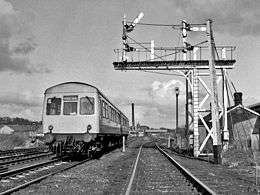British Rail Class 111
The Class 111 DMUs were based on Class 101/2s, but with different engines. The only external body difference was on the final batch of cars where a four character headcode box was fitted above the front cab windows, with the destination indicator on top of a reduced height centre window.
| British Rail Class 111 | |
|---|---|
 British Railways Metropolitan-Cammell Class 111 2-car DMU formed of E51559 and E50289 of Neville Hill depot passes Skipton forming the 15:05 Leeds to Morecambe. Sunday 20 March 1983 | |
| In service | 1957–1989 |
| Manufacturer | Metropolitan Cammell |
| Family name | First generation |
| Replaced | Steam locomotives and carriages |
| Constructed | 1957–1960 |
| Number built | 23 train sets |
| Number preserved | 1 trailer |
| Number scrapped | 22 train sets |
| Formation | 2-car sets: DMBS-DTCL or 3-car sets: DMBS-TSL-DMCL |
| Capacity | DMBS: 52 second DMCL/DTCL: 12 first 53 second TSL 71 second |
| Operator(s) | British Rail |
| Specifications | |
| Car length | 57 ft 0 in (17.37 m) |
| Width | 9 ft 3 in (2.82 m) |
| Height | 12 ft 4 in (3.76 m) |
| Maximum speed | 70 mph (113 km/h) |
| Weight | Power cars: 33 long tons 0 cwt (73,900 lb or 33.5 t) Trailer cars: 25 long tons 0 cwt (56,000 lb or 25.4 t) |
| Prime mover(s) | Two Rolls-Royce C6NFLH |
| Power output | 180 hp (134 kW) per engine, 360 hp (268 kW) per power car |
| Transmission | Mechanical: 4-speed epicyclic gearbox |
| Braking system(s) | Vacuum |
| Coupling system | Screw-link |
| Multiple working | ■ Blue Square |
| Track gauge | 4 ft 8 1⁄2 in (1,435 mm) |
History
The first cars built, part of an order for 339 Metro-Camm cars, were 4 power/trailer sets for the LMR Manchester area built in early 1957. One of these was equipped with supercharged Rolls-Royce C6SFLH 230 hp 6-cylinder engines. This was followed by ten 3-car sets comprising DMBS/TSL/DMCL for the NER at Bradford, then a further twenty 3-car sets.[1] The type lasted in service until 1989 when the class was withdrawn.[2]
Technical details
- Coupling Code: Blue Square
- Transmission: Standard mechanical
Preservation
One car survives, buffet 59575 currently operational at the Great Central Railway. It operates as the centre car between two Class 101 power cars.[3]
Fleet
| Number | Order | Type | TOPS | Weight | Seats | Lot No. | Diagram | Formation | Year |
|---|---|---|---|---|---|---|---|---|---|
| M50134–50137 | 2d | DMBS | 111/2 | 33 tons | 52 second | 30248 | BR 520 | P/Trailer | 1957 |
| E50270–50279 | 2xb | DMCL | 111/1 | 33 tons | 12 first 53-second | 30268 | BR 616 | 3-car | 1957 |
| E50280–50289 | 2xb | DMBS | 111/2 | 33 tons | 52 second | 30338 | BR 524 | 3-car | 1957 |
| E51541–51550 | 4c | DMBS | 111/2 | 33 tons | 52 second | 30508 | BR 615 | 2/3-car | 1959/60 |
| E51551–51560 | 4c | DMCL | 111/1 | 33 tons | 12 first 53-second | 30509 | BR 617 | 2/3-car | 1959/60 |
| M56090–56093 | 2d | DTCL | 147 | 25 tons | 12 first 53-second | 30337 | BR 628 | P/Trailer | 1957 |
| E59100–59109 | 2xb | TSL | 164 | 25 tons | 71 second | 30269 | BR 623 | 3-car | 1957 |
| E59569–59572 | 4c | TSL | 164 | 25 tons | 71 second | 30510 | BR 623 | 3-car | 1959/60 |
| E59573–59578 | 4c | TSBL | 165 | 25 tons | 53 second | 30615 | BR 625 | 3-car | 1960 |
References
- The Railcar Association
- Motive Power Recognition: 3 DMUs. Colin J. Marsden
- British Railway Pictorial: First Generation DMUs. Kevin Robertson
- British Rail Fleet Survey 8: Diesel Multiple Units- The First Generation. Brian Haresnape
- A Pictorial Record of British Railways Diesel Multiple Units. Brian Golding
| Wikimedia Commons has media related to British Rail Class 111. |